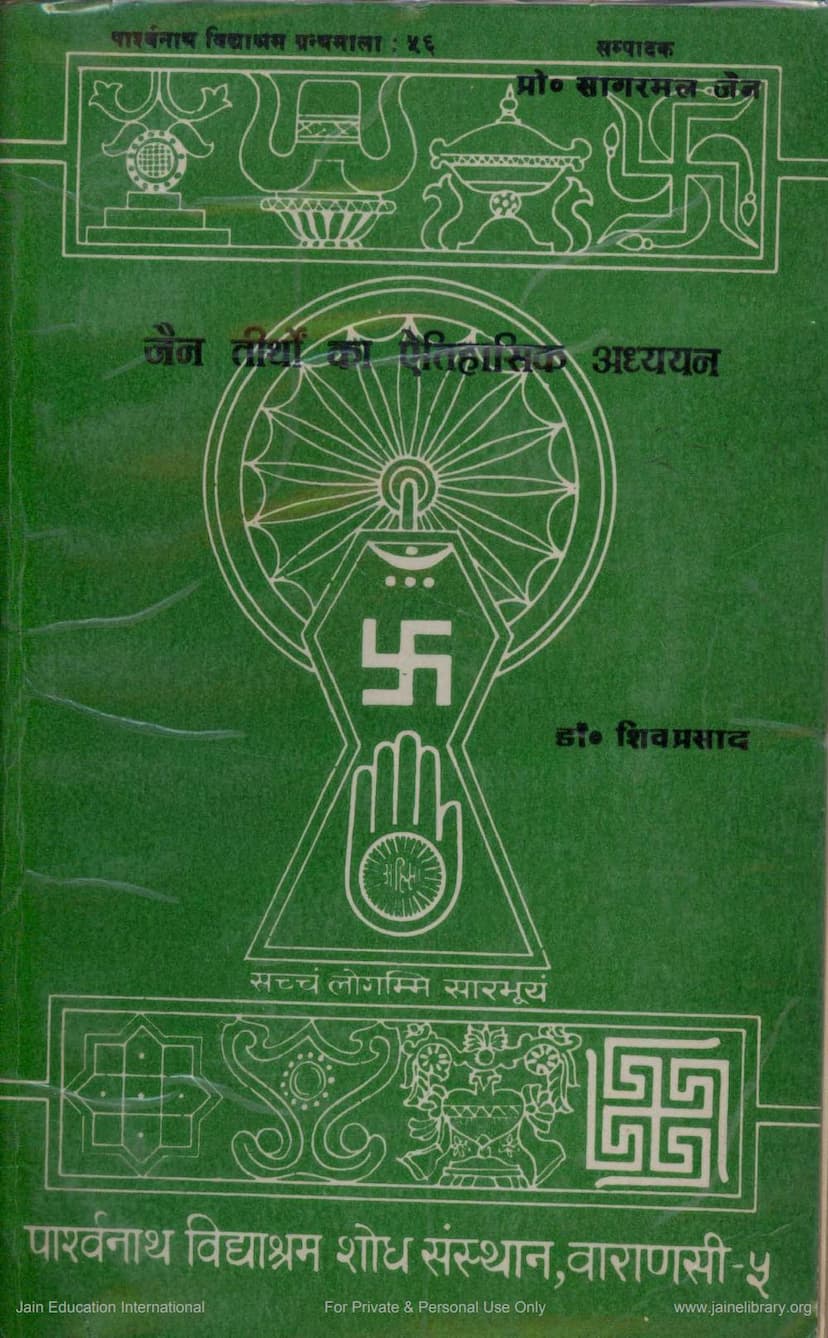Jain Tirthon Ka Aetihasik Adhyayana
Added to library: September 2, 2025

Summary
Here's a comprehensive summary of the Jain text "Jain Tirthon ka Aetihasik Adhyayana" by Shivprasad, based on the provided pages:
Book Title: Jain Tirthon ka Aetihasik Adhyayana (A Historical Study of Jain Pilgrimage Sites) Author: Dr. Shivprasad Publisher: Parshvanath Shodhpith Varanasi Published: 1991 (First Edition)
Core Theme: This book presents a scholarly historical analysis of Jain pilgrimage sites (Tirthas). It aims to move beyond traditional narratives and folklore, focusing on historical and archaeological evidence to understand the evolution and significance of these sacred places within Jainism.
Key Points and Structure:
-
Dedication: The book is dedicated to Padmashree Muni Jinavijay Ji, a significant figure in the revival of ancient Jain studies.
-
Foreword (Prakashkiy): The foreword by Bhupendranath Jain, Secretary of the Parshvanath Vidhyashram Shodhpith, highlights the critical need for a research-oriented study of Jain Tirthas. It acknowledges previous works but notes their tendency to rely more on tradition than historical rigor. The foreword explains that Dr. Shivprasad's PhD thesis, based on the "Vividh Tirtha Kalpa," was chosen for publication due to its research-based approach and the institute's commitment to unbiased scholarship, despite potential community-based obstacles.
-
Introduction (Aamukh): Dr. Shivprasad's introduction emphasizes Jainism's antiquity and the crucial role of Tirthas in its tradition. He points out the rich material available in both Shvetambara and Digambara literature regarding Tirthas, noting that dedicated works began around the 11th century CE. He identifies Jinaprabhasuri's "Vividh Tirtha Kalpa" (also known as "Kalpa Pradeep") as a foundational and superior work in this field. The author states his book is a revised version of his doctoral research, divided into nine chapters.
-
Methodology and Scope:
- Chapter 1: Subject Introduction: Surveys previous research on Jain Tirthas, discusses the source material (literary, archaeological, epigraphic), and outlines the study's methodology.
- Chapter 2: Introduction to the Author and Work: Provides a biography of the author Jinaprabhasuri and a detailed introduction to his "Vividh Tirtha Kalpa."
- Chapter 3: Spread of Jainism - Historical Survey: Offers a chronological overview of Jainism's expansion from the 6th century BCE to the 14th century CE, covering North India, South India, and Gujarat-Kathiawad.
- Chapter 4: Classification of Tirthas: Discusses the meaning of the term "Tirtha" and explains the adoption of a geographical classification (North India, East India, Central India, West India, South India) over traditional classifications (Kalyanakshetra, Siddhaksetra, Atishayakshetra).
- Chapters 5-9: Detailed Study of Tirthas: These chapters systematically analyze Jain Tirthas within each geographical region, alphabetically:
- Chapter 5: Jain Tirthas of North India: Covers 13 sites including Ayodhya, Ahichhatra, Kampilya, Koshambi, Mathura, Varanasi, Hastinapur, etc.
- Chapter 6: East India: Details Tirthas in Bihar (Kundgram, Champa Puri, Pavapuri, Sammetshikhar, etc.), Bengal, and Orissa.
- Chapter 7: Central India: Focuses on sites in Madhya Pradesh like Avanti, Oankar Parvat, Chandheri, Dashpur, Vidisha, etc.
- Chapter 8: West India: Provides extensive coverage of Tirthas in Rajasthan (Arbudagiri, Upakeshpura, Satyapur, etc.) and Gujarat-Saurashtra (Anahilpur, Dwarka, Modhera, Shatrunjay, Shankheshwar, Tamrapuri, etc.).
- Chapter 9: South India: Examines Tirthas in Maharashtra (Kolhapur, Nashik, Pratishthanpur, Shurparaka), Andhra Pradesh (Amarakonda, Shripurvat), Karnataka (Kishkindha, Gommateshwar), and Kerala (Malayagiri).
-
Significance of "Tirtha" in Jainism: The initial chapters delve into the multifaceted meaning of "Tirtha" in Jainism:
- Etymological: Derived from the root "tr" (to cross), signifying a means of crossing over.
- Literal: Refers to river banks or shores from which journeys began.
- Figurative/Spiritual: The ultimate meaning is the path to liberation (Moksha Marga) itself, established by Tirthankaras. The Tirthankara is the founder of this path. The four-fold Jain Sangha (monks, nuns, laymen, laywomen) is also considered a "Bhava Tirtha" (spiritual Tirtha).
- Distinction: Jainism differentiates between "Bhava Tirtha" (spiritual path, the Sangha) and "Dravya Tirtha" (physical sites, temples, rivers). While external purification (like bathing in rivers) is acknowledged in other traditions, Jainism emphasizes internal purification through knowledge, conduct, and faith (Ratna Traya) as the true Tirtha.
- Historical Evolution: The concept of Tirtha evolved from purely spiritual (path, Sangha) to include specific sites associated with Tirthankaras' lives (birth, enlightenment, nirvana), and later, sites with miraculous idols or grand temples (Atishayakshetra).
- Comparison with Hinduism: A key difference highlighted is that Hindu Tirthas (like the Ganga) are often considered inherently sacred, whereas Jain Tirthas derive their sanctity from their association with Tirthankaras and other great souls.
-
Source Material: The author emphasizes the importance of both literary sources (Agamas, commentaries like Niyukti, Churni, Bhashya, Vrittis, historical prabandhas, tīrthamālas) and archaeological evidence (inscriptions, idols, temple ruins) for reconstructing the history of Tirthas.
-
Analysis of Jinaprabhasuri's "Vividh Tirtha Kalpa": The book extensively analyzes this 14th-century work, which is considered a comprehensive encyclopedic survey of Jain Tirthas. The author discusses Jinaprabhasuri's life, his interactions with historical figures like Muhammad Tughluq, and the compilation of his monumental work.
-
Geographical Classification: The author's pragmatic approach is evident in his adoption of a regional classification for the Tirthas, making the study more organized and accessible.
-
Historical Context: The book provides historical context for the spread of Jainism in different regions, detailing royal patronage, periods of decline, and the development of Tirthas over centuries. It notes the influence of political shifts, like the advent of Muslim rule, on the status of Tirthas.
-
Critique of Legends: While presenting traditional accounts, the author often critically analyzes them, distinguishing between historical facts, legendary narratives, and potentially exaggerated claims, especially when comparing Jain traditions with Brahmancial and Buddhist accounts or dealing with Tirthas whose historical existence is debated.
-
Contribution: The book aims to fill a gap in scholarly research on Jain Tirthas, offering a detailed historical perspective that balances textual information with archaeological findings. It serves as a valuable resource for understanding the geographical and historical landscape of Jain pilgrimage.